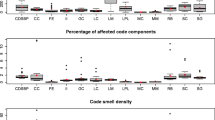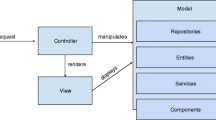Abstract
Software design problems are known and perceived under many different terms, such as code smells, flaws, non-compliance to design principles, violation of heuristics, excessive metric values and anti-patterns, signifying the importance of handling them in the construction and maintenance of software. Once a design problem is identified, it can be removed by applying an appropriate refactoring, improving in most cases several aspects of quality such as maintainability, comprehensibility and reusability. This paper, taking advantage of recent advances and tools in the identification of non-trivial code smells, explores the presence and evolution of such problems by analyzing past versions of code. Several interesting questions can be investigated such as whether the number of problems increases with the passage of software generations, whether problems vanish by time or only by targeted human intervention, whether code smells occur in the course of evolution of a module or exist right from the beginning and whether refactorings targeting at smell removal are frequent. In contrast to previous studies that investigate the application of refactorings in the history of a software project, we attempt to analyze the evolution from the point of view of the problems themselves. To this end, we classify smell evolution patterns distinguishing deliberate maintenance activities from the removal of design problems as a side effect of software evolution. Results are discussed for two open-source systems and four code smells.








Similar content being viewed by others
References
Bad Smell Evolution Results (2011) http://eos.uom.gr/~achat/SmellResults.rar. Accessed 23 June 2011
Borland Together (2011) http://www.borland.com/us/products/together/. Accessed 23 June 2011
Brown WH, Malveau RC, McCormick HW, Mowbray TJ (1998) AntiPatterns: refactoring software, architectures, and projects in crisis. Wiley, New York
Capiluppi A, Fernández-Ramil J (2007) A model to predict anti-regressive effort in Open Source Software. In: Proceedings of 23rd international conference on software maintenance (ICSM’2007), Paris, France, pp 194–203
Chan YH (2004) Biostatistics 203. Survival analysis. Singap Med J 45:249–256
Chatzigeorgiou A, Manakos A (2010) Investigating the evolution of bad smells in object-oriented code. In: Proceedings of 7th international conference on the quality of information and communications technology (QUATIC’2010), Porto, Portugal, pp 106–115
Demeyer S, Ducasse S, Nierstrasz O (2000) Finding refactorings via change metrics. In: Proceedings of 15th ACM SIGPLAN conference on object-oriented programming, systems, languages, and applications (OOPSLA’2000), Minneapolis, USA, pp 166–177
Dig D, Comertoglu C, Marinov D, Johnson R (2006) Automated detection of refactorings in evolving components. In: Proceedings of 20th European conference on object-oriented programming (ECOOP’06), Nantes, France, pp 404–428
Di Penta M, Cerulo L, Aversano L (2009) The life and death of statically detected vulnerabilities: an empirical study. Inf Softw Technol 51:1469–1484
Fokaefs M, Tsantalis N, Chatzigeorgiou A, Sander J (2009) Decomposing object-oriented class modules using an agglomerative clustering technique. In: Proceedings of 25th IEEE international conference on software maintenance (ICSM’2009), Edmonton, Alberta, Canada, pp 93–101
Fowler M (1999) Refactoring: improving the design of existing code. Addison Wesley, Boston
Gamma E, Helm R, Johnson R, Vlissides J (1995) Design patterns: elements of reusable object-oriented software. Addison Wesley, Boston
Gîrba T, Ducasse S, Lanza M (2004) Yesterday’s weather: guiding early reverse engineering efforts by summarizing the evolution of changes. In: Proceedings of 20th IEEE international conference on software maintenance (ICSM’04), Chicago, USA, pp 40–49
Hox JJ (2002) Multilevel analysis: techniques and applications. Routledge Academic, London
JDeodorant Eclipse plug-in (2011) http://jdeodorant.com/ Accessed 23 June 2011
Kagdi H, Collard ML, Maletic JI (2007) A survey and taxonomy of approaches for mining software repositories in the context of software evolution. J Softw Main Evol R 19:77–131
Khomh F, Di Penta M, Guéhéneuc YG (2009) An exploratory study of the impact of code smells on software change-proneness. In: Proceedings of 16th working conference on reverse engineering (WCRE’09), Lille, France, pp 75–84
Lehman MM, Ramil JF (2001) Rules and tools for software evolution planning and management. Ann Softw Eng 11:15–44
Marinescu R (2001) Detecting design flaws via metrics in object-oriented systems. In: Proceedings of 39th international conference and exhibition on technology of object-oriented languages and systems (TOOLS’01), Santa Barbara, USA
Martin RC (2003) Agile software development: principles, patterns and practices. Prentice Hall, New Jersey
Meyers TM, Binkley D (2007) An empirical study of slice-based cohesion and coupling metrics. ACM Trans Softw Eng Methodol 17:1–27
Moha N (2007) Detection and correction of design defects in object-oriented designs. In: Proceedings of 22nd ACM SIGPLAN conference on object-oriented programming systems, languages and applications (OOPSLA’07), Doctoral Symposiums, Montreal, Canada, pp 949–950
Moha N, Guéhéneuc YG, Duchien L, Le Meur AF (2010) DECOR: a method for the specification and detection of code and design smells. IEEE Trans Softw Eng 36:20–36
Murphy-Hill E, Black AP (2008) Refactoring tools: fitness for purpose. IEEE Softw 25:38–44
Murphy-Hill E, Parnin C, Black AP (2009) How we refactor, and how we know it. In: Proceedings of 31st IEEE international conference on software engineering (ICSE’09), Vancouver, Canada, pp 287–297
Olbrich S, Cruzes DS, Basili V, Zazworka N (2009) The evolution and impact of code smells: a case study of two open source systems. In: Proceedings of 3rd international symposium on empirical software engineering and measurement (ESEM’09), Florida, USA, pp 390–400
Parnas DL (1994) Software aging. In: Proceedings of 16th international conference on software engineering (ICSE’94), Sorrento, Italy, pp 279–287
Ratzinger J, Sigmund T, Gall HC (2008) On the relation of refactorings and software defect prediction. In: Proceedings of 5th working conference on mining software repositories (MSR’2008), Leipzig, Germany, pp 35–38
Riel AJ (1996) Object-oriented design heuristics. Addison-Wesley, Boston
Slinger S (2005) Code smell detection in eclipse. Dissertation, Delft University of Technology
Trifu A, Marinescu R (2005) Diagnosing design problems in object oriented systems. In: Proceedings of 12th working conference on reverse engineering (WCRE’05), Pittsburgh, PA, pp 155–164
Tsantalis N, Chatzigeorgiou A (2009) Identification of extract method refactoring opportunities. In: Proceedings of 13th European conference on software maintenance and reengineering (CSMR’09), Kaiserslautern, Germany, pp 119–128
Tsantalis N, Chatzigeorgiou A (2009) Identification of move method refactoring opportunities. IEEE Trans Softw Eng 35: 347–367
Tsantalis N, Chatzigeorgiou A (2010) Identification of refactoring opportunities introducing polymorphism. J Syst Softw 83:391–404
Tsantalis N, Chatzigeorgiou A (2011) Ranking refactoring suggestions based on historical volatility. In: Proceedings of 15th European conference on software maintenance and reengineering (CSMR’2011), Oldenburg, Germany, pp 25–34
Van Emden E, Moonen L (2002) Java quality assurance by detecting code smells. In: Proceedings of 9th working conference on reverse engineering (WCRE’02), Richmond, VA, pp 97–106
Xing Z, Stroulia E (2006) Refactoring practice: how it is and how it should be supported—an eclipse case study. In: Proceedings of 22nd IEEE international conference on software maintenance (ICSM’06), Philadelphia, PA, pp 458–468
Xing Z, Stroulia E (2006) Refactoring detection based on UMLDiff change-facts queries. In: Proceedings of 13th working conference on reverse engineering (WCRE’06), Benevento, Italy, pp 263–274
Acknowledgments
This work has been partially funded by the Research Committee of the University of Macedonia, Greece. We would also like to thank the anonymous reviewers of QUATIC’2010 for their constructive comments on the manuscript.
Author information
Authors and Affiliations
Corresponding author
Rights and permissions
About this article
Cite this article
Chatzigeorgiou, A., Manakos, A. Investigating the evolution of code smells in object-oriented systems. Innovations Syst Softw Eng 10, 3–18 (2014). https://doi.org/10.1007/s11334-013-0205-z
Received:
Accepted:
Published:
Issue Date:
DOI: https://doi.org/10.1007/s11334-013-0205-z




